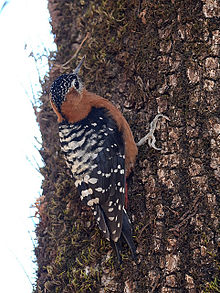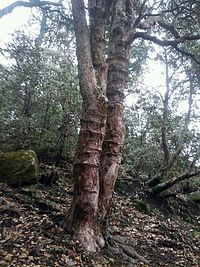Brown-throated woodpecker
| Brown-throated woodpecker | ||||||||||||
|---|---|---|---|---|---|---|---|---|---|---|---|---|

Brown-throated Woodpecker ( Dendrocopos hyperythrus ), male, |
||||||||||||
| Systematics | ||||||||||||
|
||||||||||||
| Scientific name | ||||||||||||
| Dendrocopos hyperythrus | ||||||||||||
| ( Vigors , 1831) |
The Brown-throated woodpecker ( Dendrocopos hyperythrus ) is occurring in Asia bird from the family of woodpeckers (Picidae). Some authors place the species in the genus Hypopicus .
features
The brown-throated woodpecker reaches a body length of 20 to 25 centimeters. There is a slight sexual dimorphism between the sexes . In the males, the head is bright red up to the neck, while in the females it is almost monochrome gray-black and provided with a few white dots. In both sexes, the color of the chest and stomach area varies from cloudy red-brown to strong orange-brown and its intensity can vary regionally. The birds show conspicuously black and white transversely banded wings. The face is gray-white. The long, dark control feathers are wedge-shaped and serve as a support when they move on tree trunks. The under tail coverts are reddish. The upper bill is blackish, the lower bill yellowish, the iris reddish brown. Legs and feet are olive gray.
Distribution, subspecies and habitat
In addition to the in southwest China from Nepal to Myanmar and northern Thailand occurring nominate Dendrocopos hyperythrus hyperythrus three more subspecies known:
- Dendrocopos hyperythrus annamensis ( Kloss , 1925), in southern Indochina
- Dendrocopos hyperythrus marshalli ( Hartert , 1912), in northern India , at the foot of the Himalayas and in northern Pakistan
- Dendrocopos hyperythrus subrufinus ( Cabanis & Heine , 1863), in northeast China and Korea
The main habitat of the species is mixed forests, in Pakistan forests with Himalayan poplars ( Populus ciliata ) are preferred. In China, it was detected at altitudes of up to 4,300 meters.
Way of life
nutrition
The birds, which usually live singly or in pairs, feed on various insects, primarily ants (Formicidae), which make up around 60% of the diet. Even caterpillars and beetle larvae, providing them with powerful beak strokes under the bark will bring out occasionally destroyed. Sometimes fruits and, in spring, tree sap complement the food spectrum. Tree trunks that have been intensively processed in search of tree sap show striking holes, rings, crevices or bulges.
Brood
The hatchery takes place in Bhutan, India and Nepal between April and May and in Southeast Asia between March and May. The typical woodpecker nest is carved into a tree trunk as a cave at heights between one and six meters above the ground. In addition to deciduous trees, this is sometimes also planted in pines ( Pinus ). A nest cavity is equipped with four to five eggs. The breeding and nestling times are not yet documented. Both sexes provide the young birds with food. After the breeding business ends, some birds migrate to southern and southeastern China in August or September, where they overwinter. Individual certificates for winter guests are also available from Japan, Korea, the west and south-east of Siberia and from the north-east of Mongolia.
Danger
The brown-throated woodpecker is not threatened in its range and is therefore classified by the IUCN as a ![]() " least concern ". Only in Pakistan has the felling of deciduous trees for use as animal fodder has resulted in some forests now being dominated by conifers, which are unsuitable for habitat for the brown-throated woodpecker.
" least concern ". Only in Pakistan has the felling of deciduous trees for use as animal fodder has resulted in some forests now being dominated by conifers, which are unsuitable for habitat for the brown-throated woodpecker.
Individual evidence
- ↑ Pamela C. Rasmussen & John C. Anderton, Birds of South Asia , The Ripley Guide, Vols. 1 and 2, Smithsonian Institution & Lynx Edicions, Washington, DC & Barcelona, 2005, ISBN 84-87334-67-9
- ↑ a b c d e f g H. Winkler, DA Christie & GM Kirwan (2017). Rufous-bellied Woodpecker (Dendrocopos hyperythrus). In: J. del Hoyo, A. Elliott, J. Sargatal, DA Christie & E. de Juana (eds.): Handbook of the Birds of the World Alive. Lynx Edicions, Barcelona. (viewed at http://www.hbw.com/node/56220 on July 14, 2017)
- ^ IOC World Bird List
- ^ IUCN Red List
literature
- Josep del Hoyo , Andrew Elliott, Jordi Sargatal : Handbook of the Birds of the World, Jacamars to Woodpeckers. Volume 7, Lynx Edicions, 2002, ISBN 978-84-87334-37-5 .

